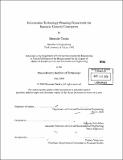| dc.contributor.advisor | Feniosky Peña-Mora. | en_US |
| dc.contributor.author | Tanaka, Shunsuke, 1965- | en_US |
| dc.contributor.other | Massachusetts Institute of Technology. Dept. of Civil and Environmental Engineering. | en_US |
| dc.date.accessioned | 2005-09-27T19:55:10Z | |
| dc.date.available | 2005-09-27T19:55:10Z | |
| dc.date.copyright | 2000 | en_US |
| dc.date.issued | 2000 | en_US |
| dc.identifier.uri | http://hdl.handle.net/1721.1/9012 | |
| dc.description | Thesis (S.M.)--Massachusetts Institute of Technology, Dept. of Civil and Environmental Engineering, 2000. | en_US |
| dc.description | Includes bibliographical references (leaves 73-74). | en_US |
| dc.description.abstract | New information technology (IT) developments continue to have a significant impact on the Architectural/Engineering/Construction (A/E/C) industry. However, the issue of whether A/E/C organizations are receiving adequate returns from their IT investments remains an important managerial concern. Recently, Pefia-Mora, Vadhavkar, Perkins, and Weber introduced a strategic IT planning framework for construction companies, which is composed of four steps: environmental scan, internal scrutiny, IT diffusion analysis, and IT investment modeling. It analyzes the external and internal IT conditions of a firm, defines the diffusion stage of IT in a firm and finally, evaluates the effects of investments on IT projects. This thesis examines the validity of applying the above-mentioned framework to the Japanese construction industry and in greater detail to Japanese general contractors, using the Kajima Corporation, one of the largest general contractors in Japan, as a case study. The Kajima Corporation is currently developing an IT project called Linkage of Information for a New Construction System (henceforth LINCS). This synthetic information network system connects design with construction work. By using the strategic IT planning framework, I evaluate LINCS in terms of its strategy and the effects of Kajima's investment on this system. | en_US |
| dc.description.statementofresponsibility | by Shunsuke Tanaka. | en_US |
| dc.format.extent | 74 leaves | en_US |
| dc.format.extent | 5676609 bytes | |
| dc.format.extent | 5676366 bytes | |
| dc.format.mimetype | application/pdf | |
| dc.format.mimetype | application/pdf | |
| dc.language.iso | eng | en_US |
| dc.publisher | Massachusetts Institute of Technology | en_US |
| dc.rights | M.I.T. theses are protected by copyright. They may be viewed from this source for any purpose, but reproduction or distribution in any format is prohibited without written permission. See provided URL for inquiries about permission. | en_US |
| dc.rights.uri | http://dspace.mit.edu/handle/1721.1/7582 | |
| dc.subject | Civil and Environmental Engineering. | en_US |
| dc.title | Information technology planning framework for Japanese general contractors | en_US |
| dc.type | Thesis | en_US |
| dc.description.degree | S.M. | en_US |
| dc.contributor.department | Massachusetts Institute of Technology. Department of Civil and Environmental Engineering | |
| dc.identifier.oclc | 47646105 | en_US |
